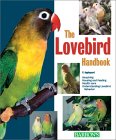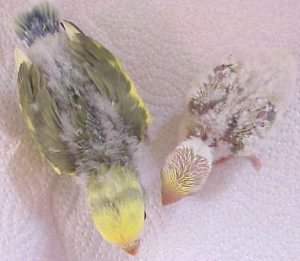The Accidental Breeder
The scenario goes like this: You have two birds, let’s say lovebirds, and they seem to be a male and female pair. You think, “Wouldn’t it be nice to have little baby lovebirds?” You put up a nestbox and wait. You aren’t really “breeding,” you are just “seeing what happens.” You are excited a few weeks later to see the hen has laid five beautiful, perfect eggs. You wait a bit more, and are thrilled one day to find the eggs have begun to hatch. Suddenly it hits you; you have no idea what to do now. Here are these squirming little babies appearing and you have so many questions.
What do I feed the mother?
What do I do if she isn’t feeding the youngest baby?
What do I do if she picks at them and they look hurt?
The problem is, this is the worst time to ask these questions. It is simply too late in many situations. The time to ask these questions is BEFORE you put up the nestbox.
If you do all your research, talk to other breeders, and prepare yourself for all the eventualities in advance, you don’t need to have the unhappy result of babies dying in the nestbox. There are a number of possible problems that can arise during the breeding cycle, from egg-binding to aggression toward babies.
Egg-Binding: This can occur if the hen depletes her calcium or if she happens to develop a particularly large egg. The photo below shows an egg that had to be imploded and removed from a Fischer’s lovebird. The egg was simply too big for her to pass.
An experienced breeder will know the early signs of an egg-bound hen and can rush her to an avian vet. This hen recovered very well and will have babies in the future. However, if the breeder does not notice the hen is in trouble early enough, the result is usually death. Early signs are a slight puffiness and an overly swollen vent. You can turn the bird over and feel if the egg is too high in the bird for the amount of swelling. Another cause of egg-binding is low calcium. The egg can develop misshapen or too soft and the hen is not able to expel it. A cuttlebone should be supplied at all times to breeding birds. Hens who overlay should be made to rest. If you get a hen who lays eggs that don’t hatch then just let her lay clutch after clutch, she will eventually deplete her calcium and be at high risk for this complication. Hens should be allowed to rest between clutches, even if the eggs do not hatch.
Neglecting Babies: This problem can vary in terms of severity. Many times the hen will care for the oldest babies and neglect the newer ones. Because birds grow so quickly, a baby born five days after its sibling is at a great disadvantage. It is very small compared with its clutchmates and cannot compete with the same vigor for the mother’s attention. In the wild, many species simply don’t bother with even the second hatch (such as macaws). They feed the oldest bird only. In the photo below you can see how much size difference there is for baby birds only five days apart.
When the hen refuses to feed the smallest babies, an experienced breeder will remove the oldest babies for hand-feeding and the mother will take over feeding the smallest babies. If you don’t know what you are doing, you won’t have this choice. You will have to hope for the best. Once again, if you do your research and learn everything you canbefore you start breeding your birds you will be prepared for this possibility. You might even find someone at a local bird store who might be willing to let you watch and learn hand-feeding. This is how I learned to feed babies.
Aggression toward Babies: Every once and a while you will get a hen or cock who becomes aggressive toward the babies. This can escalate to dangerous levels very quickly. If you are not prepared to pull these babies at any time and hand feed them, you will have a very sad situation on your hands. Sometimes the male can be removed if he is the aggressor, but you can’t remove a hen who is feeding the babies.
Diet and Nutrition: Breeding birds need an extremely balanced and varied diet. A slight increase in protein and calcium will help the hen stay healthy during the breeding season. If your birds eat only seed, they are not on a diet that will produce the healthiest babies. Get your birds on a healthy diet first, before you even think about putting the hen through the process of developing and laying eggs, brooding for weeks, and then feeding hungry chicks. During breeding season I feed pellets, seed mix, dried egg food, fresh vegetables, wheatgrass, and other items depending on the species (for instance, my Abyssinian lovebirds get figs since this is part of their diet in the wild).
The Accidental Breeder: I use this phrase because it describes it so perfectly. This is the person who most likely adores their birds and would never consciously do anything to harm them. They decide it would be wonderful to have more of these delightful creatures so they pop up a nestbox. They don’t really think about it after that, almost believing nothing will come of it. When the babies start to hatch, they rush in a panic to the computer, furiously typing out e-mails with the subject “HELP!” Sometimes the parents and babies do fine on their own, but when they don’t, the accidental breeder goes through the misery of losing the chicks and the guilt of not being prepared.
There are so many resources available these days for the beginning breeder. There are websites, mailing lists, and chat rooms. You can drop into a local bird store and ask advice. Avail yourself of these resources before you put up the nestbox.











